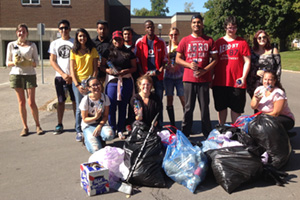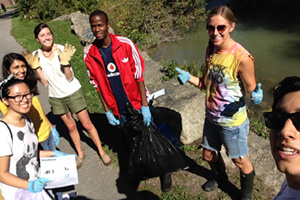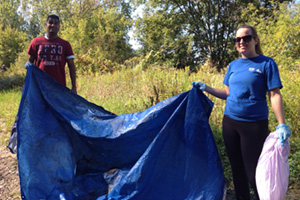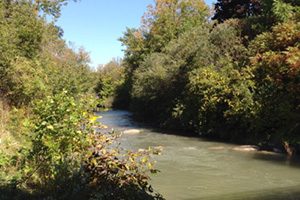UOIT students engage in the Great Canadian Shoreline Cleanup
September 29, 2014

As part of the 20th-annual Great Canadian Shoreline Cleanup, members of the University of Ontario Institute of Technology’s Blue Team came together on September 27 to clean Oshawa Creek shorelines of potentially harmful litter. The Blue Team, a group of UOIT students who are enthusiastic about creating a culture of sustainability on and off campus, was recently launched by university’s Office of Campus Infrastructure of Sustainability (OCIS). The team is part of OCIS’ Go Green, Stay Blue platform, which is focused on strengthening green initiatives on campus and in the community through active student, staff and faculty engagement.
“The UOIT Blue Team is proud to have participated in the Shoreline Cleanup for the first time ever and we plan to participate every year going forward,” said Melissa Mirowski, Sustainability Planner, OCIS. “This national conservation effort is a great chance for everyone to get involved and play an important role in keeping local water bodies healthy for our community and the plants and animals that rely on our waters for survival.”
The goal of the Great Canadian Shoreline Cleanup, presented by Loblaw Companies Ltd., is to keep bodies of water across the country clean and healthy for the wildlife and people who depend on them. By removing shoreline litter from Oshawa Creek, participants help prevent animal entanglement, water contamination and dangers for water-based activities such as boating and swimming.
Since its inception, the Great Canadian Shoreline Cleanup has mobilized more than 500,000 people across Canada to keep their local waters healthy for the wildlife and communities that depend on them. Shoreline cleanups happen along the edge of many different bodies of water – rivers, ponds, lakes, beaches and anywhere else where land and water meet.
Throughout the history of the cleanup, approximately 21,775 km of Canadian shorelines have been cleaned – the equivalent of crossing Canada three times end to end, between Vancouver, British Columbia and St. John’s, Newfoundland and Labrador. The initiative has helped remove approximately 1.2 million kg of shoreline litter – about the same weight as 259 school buses.
The Great Canadian Shoreline Cleanup is a joint conservation initiative between Vancouver Aquarium and World Wildlife Fund. It is the largest direct-action conservation initiative in Canada. This fall’s Great Canadian Shoreline Cleanup took place September 20 to 28.
For more information, visit ShorelineCleanup.ca.
3 > 1





